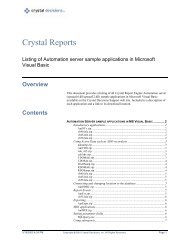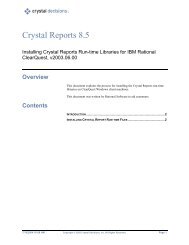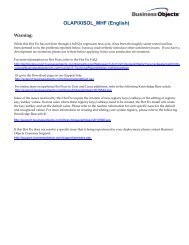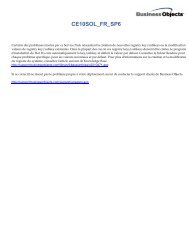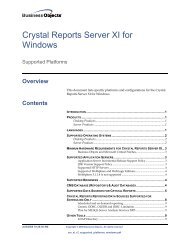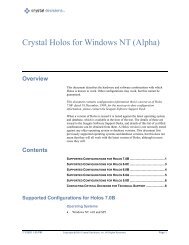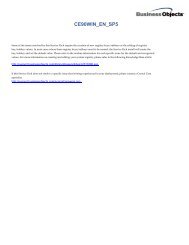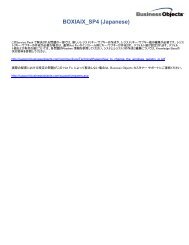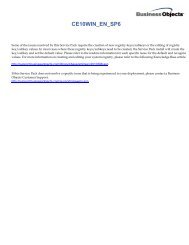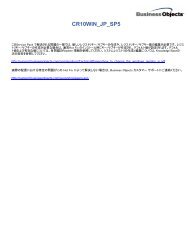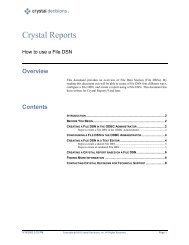Create successful ePaper yourself
Turn your PDF publications into a flip-book with our unique Google optimized e-Paper software.
<strong>Release</strong> <strong>Notes</strong><br />
The notes contained in this document cover important information that should be read before<br />
performing the Seagate Crystal Reports 8 install. Please read the entire document and be sure to<br />
visit the Seagate Crystal Reports web site at http://www.seagatesoftware.com/crystalreports for the<br />
latest product news.<br />
Users will also find product support, samples, educational documents, tutorials, tools, forums and<br />
more at the Seagate Software Community at http://community.seagatesoftware.com.<br />
Contents<br />
Installation<br />
Documentation<br />
Known Issues and Limitations<br />
Installation<br />
Additional installation instructions for Seagate Crystal Reports can be found in the file install.rtf,<br />
located in the \docs directory of the product CD.<br />
System Requirements for Seagate Crystal Reports<br />
• Microsoft Windows 95, Windows 98, Windows NT 4.0, or higher<br />
• Minimum RAM: 16 MB (32 MB for Windows NT)<br />
• Recommended RAM: 32 MB<br />
• Minimum hard drive space required: 30 MB<br />
• Maximum hard drive space required (Full Install): 210 MB<br />
Note that systems that do not meet these requirements may not run correctly.<br />
<strong>Notes</strong><br />
• It is strongly recommended that a user obtains Administrator privileges before installing<br />
Seagate Crystal Reports 8 on a machine running Windows NT or Windows 2000. The<br />
installation process may update some system files that require Administrator rights.<br />
• To install Seagate Crystal Reports 8 from an NT server, a user should NOT log on using an<br />
Administrator account.<br />
• We do NOT recommend installing a later version of Seagate Crystal Reports (e.g., Seagate<br />
Crystal Reports 8) on a machine that is running as a server for an earlier version of Seagate<br />
Info (e.g., Seagate Info 7 MR1) or for Seagate Analysis. (Seagate Crystal Reports 8 can be<br />
installed on a machine that is running standalone Seagate Analysis).<br />
1<br />
© 2000 Seagate Software
Documentation<br />
• For a brief description of the new features in this version of Seagate Crystal Reports, please<br />
refer to Chapter 2: What's New in the User's Guide and "What's New" in the online help. For<br />
a detailed description, please refer to the document features.doc, located in the \docs<br />
directory of the installation CD.<br />
• A PDF of the Crystal Reports User’s Guide can be found in the documentation folder on the<br />
CD. It will not be installed with the product.<br />
• Online help is now available in two formats, compiled HTML and non-compiled HTML.<br />
Compiled HTML help is supported by IE 3 and up. For users who must use Netscape<br />
Navigator, non-compiled HTML help is supported by Netscape Navigator 4.07 and up. For<br />
best results, use IE 5 for compiled HTML help, and Netscape Navigator 4.61 for non-compiled<br />
HTML help.<br />
Known Issues and Limitations<br />
General<br />
• On Windows NT or Windows 2000 servers, reports with NTFS permissions set up may have<br />
these permissions reset to default values (i.e., "Change" permission for "Everyone", "Full<br />
control" for "Administrator" and "System") by users who are able to open and save the report<br />
from a second machine. (The ownership of the report can also be changed to that of the user<br />
on a second machine).<br />
To prevent unauthorized access to reports with NTFS permissions, users must set<br />
appropriate permissions for the report’s corresponding folder as well.<br />
• When modifying the font size using the Fonts tab of the File|Options dialog box, users will not<br />
be able to set the font to a fractional point size (e.g., 10.5).<br />
• The ‘space’ character (used as the thousands separator in the number format for parameter<br />
fields) is not recognized when imported from a pick list text file. For example, the value<br />
‘111 222,33’ cannot be read. Users will need to manually edit the value to read ‘111222,33’ in<br />
order to correctly import the pick list.<br />
Note: When Crystal Reports exports a number or currency value to a text file, the ‘space’<br />
character is retained. Again, this space will need to be edited out if the same text file is to be<br />
used to generate a pick list for a parameter field.<br />
Compatibility Issues with Earlier Versions<br />
Version 7 and Version 8 Report Format Compatibility<br />
Although it is possible to open a version 8 Crystal Report using Seagate Crystal Reports 7, users<br />
should be aware of the following compatibility issues between the two report formats.<br />
• Version 8 reports which contain saved data cannot be opened using Crystal Reports 7. When<br />
using SCR 8 to save a report with saved data, users should save the report in version 7<br />
format if it is to be distributed in a version 7 system.<br />
2<br />
© 2000 Seagate Software
• Any reports making use of the following features should NOT be saved in version 7 format<br />
and should not be opened using Seagate Crystal Reports 7.<br />
- a report created with Seagate Crystal Reports 8 that accesses Active Data using<br />
p2smon.dll or other data using OLE DB. Users who do so will not be able to preview the<br />
report.<br />
- a report which contains Basic syntax formulas or Crystal syntax formulas that use any of<br />
the new Crystal syntax features<br />
- a report which contains percent of total summaries<br />
- a report which contains hierarchical grouping<br />
- a report created with the Excel add-in, Seagate Crystal Report Wizard. (Note: Users will<br />
be able to use Seagate Analysis to further modify the report, but will not be able to<br />
preview it. We recommend that users only use SCR 8 to make any further modifications<br />
to this type of reports.)<br />
• Excluding reports that use the features listed above, users will be able to save any report<br />
created using Seagate Crystal Reports 8 in version 7 format. Note, however, that if the feature<br />
is a new feature in version 8, the report saved in version 7 format may not be able to display it<br />
correctly. For example, if a version 8 report contains rotated text and is saved in version 7<br />
format, the text will be displayed horizontally (vertical text is a new feature in version 8).<br />
Report Layout and Formatting Compatibility between Version 8 and Earlier Versions<br />
In Seagate Crystal Reports 5, 6 and 7, text objects are not displayed or printed with the exact font<br />
size that the user specifies (a smaller font size is used instead). This behavior has been improved<br />
significantly in this release: text objects are now displayed and printed with the exact font size that<br />
is specified by the user and they are WYSIWYG.<br />
However, depending on how a report has been formatted, a report being run on earlier versions of<br />
Seagate Crystal Reports may appear different in the current release (with respect to line breaks<br />
and spacing within text objects). This is because the font size used to display and print text<br />
objects is now exact and different from that used in previous versions.<br />
In order to preserve the line breaks and spacing in text objects of earlier reports as much as<br />
possible, there is now a "7.0 Text Compatibility" option under Options | Reporting. If this option is<br />
ON when a report created in version 5, 6 or 7 is opened, then the font size of text objects is<br />
automatically adjusted to be both compatible with that used in the earlier version and WYSIWYG.<br />
This option is checked by default. If a user turns this option OFF for a report created with version<br />
5, 6 or 7, the user may notice that lines within a text object break earlier than in the earlier release,<br />
and spacing within the object may be upset.<br />
Note: With the option checked, lines within a text object may still occasionally break at a different<br />
location than in an earlier version, but the formatting will not be significantly upset and no text<br />
should be missing.<br />
3<br />
© 2000 Seagate Software
Crystal Report Viewer for ActiveX Compatibility with Seagate Info 7<br />
• When the Crystal Reports 8 Viewer for ActiveX is installed on a machine on which Seagate<br />
Info 7 resides, the Info Viewer (Windows32, Page-On-Demand implementation) will cease to<br />
function correctly.<br />
To resolve this issue, users will need to run the executable CVWAX.EXE, located in the<br />
\Tools\CVWAX directory of the Crystal Reports 8 product CD. This will launch an install<br />
program which will replace the existing Info Viewer program file (cvwax32.exe).<br />
• Users will not be able to use the SCR 8 Crystal Report Viewer for ActiveX to view Report<br />
Packages from Seagate Info 7.x.<br />
Likewise, if SCR8 is installed on a Seagate Info 7.x client machine (or if the Crystal Report<br />
Viewer for ActiveX is downloaded from an SCR8 Web Component Server), both ActiveX<br />
implementations of the Info Viewer (the Windows32 and Info WebAccess versions) cannot be<br />
used to view Report Packages.<br />
Access Add-in<br />
• Currently, if an Access database is protected by passwords, users will not be able to create a<br />
report off that database using the Access Add-in. Users who attempt to do so will encounter<br />
one of the following error messages:<br />
• If the Add-in is invoked using ‘Tools|Add-ins|Seagate Crystal Reports’, Access will issue<br />
the message “Microsoft Access can’t find the wizard…”<br />
• If the Add-in is invoked using ‘New|Seagate Crystal Report Wizard’ from the Reports tab,<br />
Access will issue the message “This feature isn’t installed.”<br />
• When you install Seagate Crystal Reports 8, the Access Add-in files will be placed in the<br />
...\Program Files\Seagate Software\Report Designer Component directory by default. The<br />
Access Add-in will automatically be installed onto Access and will be loaded every time<br />
Access is started.<br />
Charting<br />
• With Seagate Crystal Reports 8, users will be able to insert pictures into a selected area<br />
object in the Analyzer. Note, however, that because Microsoft Office provides these pictures,<br />
MS Office must be installed before this formatting function can be used.<br />
Crystal Report Print Engine (CRPE) API<br />
• The CRPE API defaults to Crystal syntax.<br />
The new structure PEFormulaSyntax.formulaSyntax [0] defaults to PE_FST_CRYSTAL.<br />
Applications can use the new function PESetFormulaSyntax and set the syntax to be<br />
PE_FST_CRYSTAL or PE_FST_BASIC. They can also use PEGetFormulaSyntax to obtain<br />
user's input for the syntax.<br />
4<br />
© 2000 Seagate Software
Database Drivers<br />
• DB2 and Sybase database drivers are not installed when performing a ‘Complete Installation’<br />
on machines with a DB2 or Sybase client. Users will need to choose ‘Custom Installation’ to<br />
specifically install these drivers.<br />
• With the current version of Seagate Crystal Reports, only ACT!3 and ACT!4 databases are<br />
supported. ACT!1 and ACT!2 are no longer supported.<br />
• Users will only be able to access ACT! databases that are of the same version as that<br />
residing on the user’s machine. For example, users running ACT! 4 on their machines will not<br />
be able to report off an ACT! 3 database, and vice versa.<br />
• Non-SQL native drivers only support LEFT OUTER JOINs<br />
Only LEFT OUTER JOIN can be used when linking two tables of any one of the following<br />
types of databases through their native drivers:<br />
− Exchange Folders/Address Book (p2smapi.dll)<br />
− Local File System (p2sfs.dll)<br />
− Mailbox Admin (p2sexsr.dll)<br />
− Message tracking log (p2strack.dll)<br />
− MS IIS/Proxy Log Files (p2smsiis.dll)<br />
− NT Archived Event Log (p2sevt.dll)<br />
− NT Current Event Log (p2sevt.dll)<br />
− Outlook (p2soutlk.dll)<br />
− Public Folder ACL (p2sacl.dll)<br />
− Public Folder Admin (p2sexsr.dll)<br />
− Public Folder Replica (p2srepl.dll)<br />
− Web/IIS Log Files (p2swblg.dll)<br />
− Domino Server\Lotus <strong>Notes</strong> (p2snote.dll)<br />
• Currently, foreign key information is supported in the following databases using the specified<br />
drivers:<br />
ODBC OLE DB<br />
SQL<br />
Database Native<br />
ODBC Providers Other ODBC OLE DB via ODBC OLE DB via other<br />
Shipped with SCR 8 Providers<br />
Providers<br />
SQL Server (Yes) ODBC-MSSQL OLE DB-ODBC OLE DB-SQL<br />
(Yes)<br />
(Yes)<br />
(Yes)<br />
Oracle (Yes) ODBC-CROR7<br />
(Yes)<br />
ODBC-CROR8<br />
(Yes)<br />
Informix (No) ODBC-CRINF<br />
(Yes)<br />
Sybase (No) ODBC-CRSYB<br />
(No)<br />
DB2 (No) ODBC-CRDB2<br />
(No)<br />
SYB11<br />
(No)<br />
5<br />
© 2000 Seagate Software<br />
OLE DB-ODBC<br />
(Yes)<br />
OLE DB-ODBC<br />
(Yes)<br />
OLE DB-ODBC<br />
(No)<br />
OLE DB-ODBC<br />
(No)<br />
OLE DB-Oracle<br />
(Yes)
Access (No) MS Access<br />
(No)<br />
Distributing Reports<br />
6<br />
© 2000 Seagate Software<br />
OLE DB-ODBC<br />
(No)<br />
OLE DB-Access<br />
(Yes)<br />
• The Compile Report option and the Report Distribution Expert are no longer available with this<br />
release. Users are encouraged to distribute reports over the Internet using the Web<br />
Component Server. The Web Component Server offers a more centralized administration for<br />
reports, requires no client-side installation, minimizes network traffic and lets users scale up<br />
to Seagate Info for advanced scheduling and security. Users can also open the same reports<br />
in Seagate Analysis that offers querying and analyzing capabilities. For more information on<br />
migrating from compiled reports to distributing reports over the Web, please read the<br />
technical brief available on the Seagate Software Community web site, at<br />
http://community.seagatesoftware.com. For information on using the Web Component Server,<br />
please refer to Chapter 17 of the User's Guide, and the Web Reporting Administrator's Guide.<br />
• For existing users who choose to continue using the Compile Report option and the Report<br />
Distribution Expert, these components will be available for download as the "Compile Reports<br />
and Distribution Expert" component from the Seagate Software Community web site, at<br />
http://community.seagatesoftware.com. After downloading and installing this component, two<br />
options, "Compile Report" and "Report Distribution Expert", will be available under the Report<br />
menu of the Crystal Report Designer.<br />
Displaying the Euro Symbol<br />
Users who want to display in their reports the Euro symbol should take note of the following: if the<br />
user is running Windows NT 4 SP4 / SP5 or Windows 2000, this is supported and the user should<br />
already have Euro-enabled fonts. If the user is running Windows 95, 98 or NT 4, the user will have<br />
to download a Euro patch and / or additional Euro-enabled fonts. Most Euro-enabled fonts are<br />
True Type fonts.<br />
To download the Euro patch and obtain more information on which fonts are Euro-enabled for the<br />
corresponding operating systems, please refer to the Microsoft web site at:<br />
http://www.microsoft.com/typography/faq/faq12.htm#w95<br />
After installing the Euro patch, users should select the appropriate Euro-enabled font in<br />
Options|Editors. The user can then insert the Euro symbol in the Formula Editor, SQL Editor and<br />
Format Editor by typing Alt-0128.<br />
Excel Add-in<br />
• When you install Seagate Crystal Reports 8, the Excel Add-in files will be placed in the<br />
…\Program Files\Seagate Software\Report Designer Component directory by default. The<br />
Excel Add-in will automatically be installed onto Excel and will be loaded every time Excel is<br />
started unless you uncheck it in the Add-ins dialog box.<br />
• When the Crystal Report Designer and Microsoft Excel are run simultaneously on the same<br />
machine, users will encounter an error if both programs access the same workbook as data.<br />
This is because Excel may disrupt the OLE DB connection that the Crystal Report Designer<br />
sets up with the workbook. A sequence of events where this becomes an issue is detailed in<br />
the following:
• A report that has been created on a workbook is opened in the Crystal Report<br />
Designer. (Thereby setting up an OLE DB connection to the workbook).<br />
• In Excel, the user modifies the workbook by adding a named range. (This will disrupt<br />
the OLE DB connection that has been set up between the Crystal Report Designer<br />
and the workbook).<br />
• When the user attempts to open the report again in the Crystal Report Designer, the<br />
user will get the following error messages: "No rowset was returned for this table,<br />
query, or procedure." and "Error detected by database DLL."<br />
(Note: If the user uses the Seagate Crystal Report Wizard to create a report on the same<br />
workbook in step (ii), instead of modifying the workbook in Excel, the same error occurs).<br />
To avoid the error before step (iii), users will need to close and re-open the Crystal Report<br />
Designer. (When the user opens the report, the OLE DB connection will be re-established).<br />
• With the current implementation, a user can use Seagate Analysis to modify a report created<br />
with the Excel Add-in. However, the user will not be able to preview the report. For more<br />
information, see the notes under "Version 7 and Version 8 Report Format Compatibility"<br />
above.<br />
• The Excel Add-in can only be used with files in XLS format. For example, users who import a<br />
file into Excel (such as a comma-separated value file) must first save the file in Excel (.xls)<br />
format before the Add-in can be used.<br />
Export<br />
Note: If the Excel Add-in is used on a non-XLS file, the following error message is returned:<br />
“Server has not yet been opened.”<br />
• Seagate Crystal Reports 8 no longer supports the following export formats:<br />
• Excel 2.0<br />
• Excel 3.0<br />
• Excel 4.0<br />
• HTML 3.0<br />
We recommend that users who need to export their reports to Excel do so using Excel 5.0<br />
(XLS) or higher. Likewise, in place of exporting to HTML 3.0 format, we recommend users<br />
export to HTML 3.2 format. (Note: HTML 4.0 is for DHTML-capable browsers only – Internet<br />
Explorer 4 or later and Netscape Navigator 4 or later).<br />
Note: Existing applications using the CRPE API, Automation Server or the Report Designer<br />
Component Runtime will now return an error message if the user selects one of the<br />
unsupported formats. The error code is 692, and the error message is "Invalid export DLL or<br />
export format". Users are encouraged to choose an alternative format as described above.<br />
• A Beta version of the export driver for Acrobat (PDF) format is now available for download<br />
through the Seagate Software Community web site at http://community.seagatesoftware.com.<br />
Users can download the driver, U2FPDF.DLL. For Windows 9x systems, place it in the<br />
x:\Windows\Crystal folder, and for Windows NT systems, place it in x:\Winnt\Crystal, where x<br />
is the drive that Seagate Crystal Reports has been installed onto. (Please note that Technical<br />
Support will not be able to provide support for this export driver, as with all Beta software. For<br />
7<br />
© 2000 Seagate Software
more information on the Acrobat export driver, please refer to the README that will also be<br />
available for download.)<br />
With the current implementation, a number of limitations exist:<br />
- This release of the export driver is only supported by Seagate Crystal Reports 8, and will<br />
fail if run on any earlier version of Seagate Crystal Reports.<br />
- Only True Type fonts are supported. Non true-type fonts will be substituted with Times<br />
New Roman.<br />
- Word wrapping is slightly different than in the Crystal Report Designer.<br />
- Only the Standard ISO-Latin1 character set (English character set) is supported.<br />
- While bitmaps using 1, 4, 8, 24 and 32-bit color encoding are supported, 16-bit color<br />
encoded bitmaps are NOT supported.<br />
- Area and section background colors are not supported.<br />
- Objects that overlap one another may not appear in the exported report as they did in the<br />
original report.<br />
- Bitmaps using Run Length Encoding (RLE) are not supported.<br />
- Lines and boxes within reports are currently not supported<br />
- Rotated text within reports is currently not supported.<br />
- Object border support is limited to single line borders.<br />
- Reports with multi-columns are currently not supported.<br />
- Reports with groups that are to be kept together are not supported.<br />
- Only basic cross-tabs are supported; cross-tabs with the new formatting options in this<br />
version are not yet supported.<br />
- Text objects in row and column headers in a cross-tab may not be positioned in the<br />
exported report as in the original report.<br />
- On-demand subreports are expanded in-line.<br />
- Shared variable values may be exported incorrectly.<br />
Formula Language<br />
• The variable "formula" must return a value in a valid Basic syntax formula. This is one of the<br />
main differences between Basic syntax and Visual Basic script. When running Basic syntax<br />
examples from the Online Help in the Formula Editor, take note that some of these examples<br />
are syntactically correct but may not be complete in that they do not assign the variable<br />
"formula". For more information on assigning "formula", please refer to the section "Basic<br />
syntax fundamentals" in the Online Help.<br />
• Because formatting of fields is optimized and may not always be executed upon refresh,<br />
formulas set up for conditional formatting should avoid side effects like setting global or<br />
shared variables.<br />
Mapping<br />
• Occasionally, drilling down on some maps may result in an incorrect map being displayed, or<br />
no map being displayed. This is a known issue with earlier versions of Crystal Reports and is<br />
caused by a lack of maps. Because more maps are provided with this release, this situation<br />
will occur more infrequently.<br />
8<br />
© 2000 Seagate Software
OLAP Reporting<br />
• The function GridRowColumnValue is displayed in the functions tree in the Formula Editor<br />
when applying conditional formatting to a grid label. Please note that although the function is<br />
displayed, it is non-functional in this context; it is only functional when a value in a cell has<br />
been selected.<br />
• Conditional formatting for OLAP grid values using GridRowColumnValue is affected if rows or<br />
columns are subsequently added or deleted from the grid.<br />
• Users will only be able to connect to an OLAP cube once with a report. As a result, the<br />
following limitations apply:<br />
- If users create a new report with an OLAP cube, they will not be able to refresh the report<br />
unless it is closed and re-opened.<br />
- If users open an OLAP report with saved data, it can only be refreshed once unless the<br />
report is closed and re-opened.<br />
- If users open an OLAP report that has not been saved with data, it can only be refreshed<br />
once and will display the Preview Tab. They may not refresh it again, unless they close it<br />
and re-open it.<br />
- If users have an OLAP cube in a relational report, the same conditions as those specified<br />
above hold for refreshing data from the OLAP cube. At other times, when they refresh,<br />
they will only be refreshing the relational data but not the OLAP data in the report.<br />
• NULL field names are not supported in an OLAP dimension. As an example:<br />
A dimension Region with 3 levels:<br />
Level 0: country<br />
Level 1: state<br />
Level 2: city<br />
USA<br />
Canada<br />
BC<br />
Spain<br />
California<br />
""<br />
Los Angeles<br />
Vancouver<br />
Madrid<br />
The NULL field name in Level 1 under "Spain" is not allowed and will cause incorrect data to<br />
be displayed in the report.<br />
• Installing Informix MetaCube<br />
The Informix Client 2.8 and the MetaCube Client 4.02 install MFC42.DLL v. 4.21.7160.<br />
Seagate Crystal Reports 8 requires MFC42.DLL v.6.00.8267.0 or later to run. Consequently, if<br />
users need to access data on an Informix MetaCube and plan to install Informix MetaCube,<br />
they should do so before installing Seagate Crystal Reports 8 so that they will have the<br />
appropriate version of MFC42.DLL.<br />
9<br />
© 2000 Seagate Software
• Version 7 OLAP report running on Seagate Crystal Reports 8<br />
If a version 7 OLAP report has an "equal to" dimension, a record selection formula would<br />
actually be generated in the background. When users open this report in Seagate Crystal<br />
Reports 8 and modify any record selection criteria (for example, changing the previous "equal<br />
to" dimension to a paged dimension), they will get different records selected. This is because<br />
the record selection formula generated in version 7 still remains in the report. Users will need<br />
to choose Report | Edit Selection Formula | Record to either remove the formula or modify it<br />
accordingly.<br />
• Essbase Report Script no longer supported<br />
- Please note that Seagate Crystal Reports 8 no longer supports Essbase Report Script<br />
method.<br />
- To create new reports on Essbase data, use the enhanced driver, ESSBHAPI.DLL, that<br />
supports a variety of new features for the Grid Object method of Essbase reporting. This<br />
driver is automatically installed when installing Seagate Crystal Reports 8. (For more<br />
information, please refer to the document “SCR8 and Hyperion Essbase.pdf” located in<br />
the \Docs directory of the product CD).<br />
• Viewing an OLAP .HDC report on the Web<br />
Windows NT users who attempt to view an OLAP report created off an HDC cube on the web<br />
may be prompted to log on. This will occur if the Seagate Page Server is running as a service<br />
on a System account that does not have the required rights to the .HDC data. When this<br />
occurs, users will need to go to the Services Control Panel and stop the "Seagate Page<br />
Server" service. Then, restart the Page Server service, logging on with an account that has<br />
access rights to the .HDC cube.<br />
• OLE DB provider for OLAP<br />
This release supports two OLE DB providers for OLAP: Microsoft OLAP and SAP BW. Users<br />
who need to connect to SQL Server 7 OLAP Services should use MSOLAP as the provider<br />
name.<br />
• Inserting an OLAP grid into a relational report<br />
Suppose a user inserts an OLAP grid into a report that is grouped on a relational data field,<br />
Field A, and the user specifies a page dimension, Dimension D, for the grid such that there is<br />
a grid for each of the values of Field A. The short field names of Dimension D must match<br />
values of Field A in order for the appropriate grid to be displayed.<br />
For example, if Field A has data values, "United States", "Canada" and "Mexico", and<br />
Dimension D has input values whose short field names are "USA", "CAN" and "Mex", because<br />
the values of A do not match the short field name of input values of D, grids will not be<br />
displayed correctly for each grouping on A. The short field names must have the same values<br />
as A in order for the appropriate grid to be displayed for each grouping on A.<br />
10<br />
© 2000 Seagate Software
• Failure to connect to MS OLAP Server<br />
If the SQL Server 7 OLAP Service Patch (Sql70OlapSpli.exe) has been installed and<br />
connecting to MS OLAP Server fails, please refer to the ReadMe.txt for the MSOLAP Service<br />
Patch for the security changes.<br />
• Users may not keep OLAP data sources in the Favorites or History list in the Data Explorer.<br />
• Verify database if OLAP cube structure has changed<br />
Similar to performing Verify Database on relational databases, if an OLAP cube structure has<br />
been changed, the user must Verify Database before a successful refresh can be<br />
accomplished. Otherwise, the refresh will fail; the user must close the report, re-open it and<br />
then Verify Database in order to be able to refresh properly.<br />
• All existing OLAP grids (and cross-tabs) have "Custom" style<br />
The following applies to both OLAP grids and cross-tabs:<br />
Initially, when an OLAP grid is created, it has by default the "Original" style. A user can choose<br />
one of the pre-defined styles as a template and create a grid based on the template. A user<br />
may then further customize the style of the grid.<br />
Currently, although the Crystal Report Designer supports a customized style for a grid, it does<br />
not keep track of what the previous style is and what changes have been applied to it. That is,<br />
it only keeps track of the current layout and format of the grid. Regardless of any<br />
customization, the grid will subsequently assume a "Custom" style.<br />
Hence, after an OLAP grid has been created, it always assumes a "Custom" style. If a user<br />
re-enters the Style tab of the Format OLAP Grid Object dialog box or the OLAP Report<br />
Expert, the user will always see the "Custom" style as the selected style for the grid.<br />
Furthermore, if the user selects the same pre-defined style that has been used as a template<br />
for the grid, the user will still be prompted with a message that a new style has been selected<br />
and that customized changes will be lost. At this point, the user can confirm "yes" if changes<br />
are certain.<br />
On-demand Subreports<br />
• Saving data with reports containing on-demand subreports.<br />
When a user saves data with a report that contains an on-demand subreport, data is only<br />
saved for the main report. It is not saved for the on-demand subreport unless the on-demand<br />
subreport is opened in a Preview tab. (In which case, data will be saved for the main report<br />
and that subreport).<br />
• Exporting to .RPT format reports with on-demand sub report<br />
When a user exports a report that contains an on-demand subreport to .RPT format, only the<br />
main report will be exported. (Unless the user has previewed the on-demand sub report, in<br />
which case, the main report and that subreport will also be exported).<br />
11<br />
© 2000 Seagate Software
Oracle8 Support<br />
The native Oracle driver has not been upgraded to support Oracle8. Consequently, to use an<br />
Oracle8 feature, (e.g. access new data types like BLOB's, CLOB's, REF's and user-defined data<br />
types in Oracle8), either define BLOBs=LONG RAW and CLOBs=LONG or use the ODBC or OLE<br />
DB driver for Oracle.<br />
Report Designer Component<br />
• The method, SortDirection, for the interface, iSortTabGroup, supports sorting in ascending or<br />
descending order, but not sorting in original or specified order. (i.e., do not assign<br />
crOriginalOrder or crSpecifiedOrder to SortDirection).<br />
• Certain report creation methods and properties have been added to the Report Designer<br />
Component and the Report Designer Component Runtime (i.e., Baja). Before distributing any<br />
applications that use any of these methods and properties, please obtain proper licensing.<br />
• For a String type report variable, the maximum length is 255 bytes, including the Null byte. If a<br />
user sets a String value of more than 255 bytes to such a Report Variable, the value will be<br />
truncated.<br />
• Failure to connect to some OLAP databases from the RDC<br />
Currently, in the Report Designer Component, a user can run an OLAP report off an HDC or<br />
Microsoft OLAP database. The user cannot connect to the following OLAP databases from<br />
the RDC: Essbase cube, Informix MetaCube, IBM DB2 cube or SAP BW cube. Since by<br />
design, when an OLAP report is opened, an attempt is automatically made to connect to the<br />
database and refresh the report, the user should not open an OLAP report that reports off any<br />
of these types of servers.<br />
• Currently, a user cannot do a set location for an OLAP data source in the Report Designer<br />
Component.<br />
• RDC runtime defaults to Crystal syntax<br />
The new FormulaSyntax property of the Report object defaults to Crystal syntax. Applications<br />
can set this property to Basic or Crystal syntax, by assigning the values<br />
crBasicSyntaxFormula and crCrystalSyntaxFormula repectively.<br />
• Online help<br />
UFL's<br />
When a user clicks the help button after adding a Crystal Report through the RDC, the Report<br />
Designer Component Online Help appears with a blank screen. Use the Contents or Index<br />
buttons on that screen to see a list of help topics.<br />
• The Essbase functions in the Formula Language are no longer supported. These functions<br />
include:<br />
EssbaseAlias<br />
EssbaseAncestor<br />
EssbaseConsolidationType<br />
12<br />
© 2000 Seagate Software
EssbaseExpenseReporting<br />
EssbaseFormula<br />
EssbaseGeneration<br />
EssbaseLevel<br />
EssbaseNativeName<br />
EssbaseSharedMember<br />
EssbaseTag<br />
EssbaseUDA<br />
Web Folders<br />
• Accessing reports with "Read Only" permissions in Web folders<br />
If the user attempts to access a report that has “Read Only” permissions set on the server,<br />
the user may encounter a network identity challenge. If this does appear, attempting to give a<br />
username and password will cause SCR to fail. Please click on the “Cancel” button and<br />
change the file permissions on the server.<br />
Web Reporting<br />
• Netscape Navigator 3.04 is no longer supported for viewing reports with the Crystal Report<br />
Viewer for Java. Users can use the Crystal Report Viewer for HTML with this release of<br />
Netscape. To use the Crystal Report Viewers for Java and ActiveX, users will need Netscape<br />
Navigator 4 or above. (Note that to use the Crystal Report Viewer for ActiveX on a Netscape<br />
browser, users should also install the Netscape Plugin for ActiveX).<br />
• Currently, if an Active Server Page accesses the Report Designer Component that resides not<br />
on the Web server but on a Microsoft Transaction Server (MTS) on a different machine, the<br />
HTML page it generates will not contain any images (e.g., charts, maps). The user viewing<br />
the report with the Crystal Report Viewer for HTML will not be able to see any images.<br />
• NTFS permissions are checked against the account that the Seagate Page Server is running<br />
under<br />
NTFS permissions are checked against the account that the Seagate Page Server is running<br />
under and not against the user account that is trying to view the report. This means that if the<br />
Seagate Page Server is running on an account that can access the report, then the report can<br />
always be viewed regardless of the rights of the person doing the viewing.<br />
• Changing rights on a report on a Web server with NTFS permissions set up<br />
A user previews a report on a Web server with NTFS permissions set up, and closes the<br />
report. Subsequently, rights on the report are changed to something lesser. However, the<br />
same user will still be able to access the report with the previous rights.<br />
To prevent unauthorized access after changing the rights, after downgrading the permissions,<br />
the Seagate Page Server on which the report resides should be restarted.<br />
• Shared cache of the Web Component Server refreshed prematurely<br />
If a user uses shared cache for report viewing on the Web (by setting the Database Refresh<br />
Interval of the Crystal Report Web Component Server to a value greater than 0), then as the<br />
cache becomes full and needs to be flushed out, the cache is actually refreshed before the<br />
13<br />
© 2000 Seagate Software
set time interval is reached. This situation arises when there is a sufficiently large number of<br />
requests from users sharing the same cache accessing their databases.<br />
• Page Server should always be run as an Administrator Account<br />
The Page Server should always be run as an Administrator Account. Otherwise, a user may<br />
encounter the following problems:<br />
- If a user attempts to view an OLAP report over the Web, the Page Server will be denied<br />
access and the user will be requested to log on to the OLAP server unnecessarily.<br />
- If a user attempts to access over the Web an MS SQL Server database via ODBC, unless<br />
the Page Server is running under an Administrator or local system account, it will be<br />
denied access to the data source.<br />
• The chart below identifies further limitations which pertain to the Crystal Report Viewers.<br />
Unless otherwise stated, limitations apply to the corresponding viewer running on Netscape<br />
and Internet Explorer:<br />
HTML (Plain) HTML (Frame) Java (Browser Java (Java ActiveX Netscape Plug-<br />
JVM)<br />
Plug-in)<br />
in<br />
Box objects No Yes Always appear Always appear Yes Yes<br />
with single with single<br />
borders.<br />
borders.<br />
Line objects No Appear as Always appear Always appear Yes Yes<br />
single.<br />
as single. as single.<br />
Other objects: Appear as double. No on<br />
Yes Yes Yes Yes<br />
single borders<br />
Netscape.<br />
Yes on IE.<br />
Other objects: Appear as bold No on<br />
Yes Yes Yes Yes<br />
double border double.<br />
Netscape.<br />
Yes on IE.<br />
Other objects: Appear as double. No on<br />
Appear as Appear as Yes Yes<br />
dashed and dotted<br />
Netscape. single.<br />
single.<br />
borders<br />
Appear as<br />
single on IE.<br />
Group tree in No Only part of Yes Yes Yes Yes<br />
hierarchical report<br />
group tree can<br />
be expanded at<br />
one time.<br />
Hyperlink Yes Yes Only hyperlinks Only hyperlinks Yes Yes<br />
to a Web site or to a Web site or<br />
e-mail address e-mail address<br />
are support-ed. are support-ed.<br />
Match font used in<br />
report<br />
Yes Yes No Yes Yes Yes<br />
Network logon per User must log on User must log User must log User must log User must log User must log<br />
report<br />
at least once per on at least once on at least once on at least once on at least once on at least once<br />
report even if per report even per report even per report even per report even per report even<br />
reports use the if reports use if reports use if reports use if reports use if reports use<br />
same data the same data the same data the same data the same data the same data<br />
source.<br />
source.<br />
source.<br />
source.<br />
source.<br />
source.<br />
Network logon per User must log on User must log User must log User must log User must log User must log<br />
subreport<br />
separately per on separately on separately on separately on separately on separately<br />
subreport even if per subreport per subreport per subreport per subreport per subreport<br />
it uses the same even if it uses even if it uses even if it uses even if it uses even if it uses<br />
data source as the same data the same data the same data the same data the same data<br />
the main report. source as the source as the source as the source as the source as the<br />
main report. main report. main report. main report. main report.<br />
On-demand<br />
subreport<br />
No No Yes Yes Yes Yes<br />
14<br />
© 2000 Seagate Software
Overlapping<br />
objects<br />
Parameter<br />
prompting<br />
No No Yes Yes Yes Yes<br />
Default values,<br />
validation,<br />
masking, multiple<br />
values and ranges<br />
are not supported.<br />
Default values,<br />
validation,<br />
masking,<br />
multiple values<br />
and ranges are<br />
not support-ed.<br />
Default values,<br />
validation,<br />
masking,<br />
multiple values<br />
and ranges are<br />
not support-ed.<br />
Rotated Text No No Only for vertical<br />
fonts (e.g.<br />
Japanese). Latin<br />
fonts are<br />
displayed<br />
upright in<br />
columns.<br />
Search for text Begins searching<br />
on the next page<br />
and not current<br />
page, and does<br />
not highlight<br />
found text.<br />
Begins<br />
searching on<br />
the next page<br />
and not current<br />
page, and does<br />
not highlight<br />
found text.<br />
15<br />
© 2000 Seagate Software<br />
Default values,<br />
validation,<br />
masking,<br />
multiple values<br />
and ranges are<br />
not support-ed.<br />
Default values,<br />
validation,<br />
masking,<br />
multiple values<br />
and ranges are<br />
not support-ed.<br />
Yes Yes Yes<br />
Yes Yes Yes Yes<br />
• VeriSign root certificate expiring for Netscape browsers 4.01 through 4.05<br />
As of Oct. 15, 1999, Netscape no longer supports Netscape 4.0x browsers. The VeriSign<br />
security certificate for these versions of Netscape browsers has also expired on Dec. 31,<br />
1999. This means that users of these browsers may not be able to successfully download<br />
applications signed with Netscape Object Signing ID's. When users with these versions of the<br />
Netscape browser attempt to view with the Crystal Report Viewers for Java and Java Plug-in,<br />
they may be informed that "SmartUpdate failed; JAR archive failed security check. Issuer<br />
certificate is invalid." Users should then download the latest version of the Netscape browser<br />
before viewing the report.<br />
• The maximum length for tool tips in Crystal Report Viewer for ActiveX is 80 characters<br />
• Cannot view report via the ASP server with the Crystal Report Viewer for Java Plug-in on<br />
Netscape browsers<br />
Viewing reports via the ASP server with the Crystal Report Viewer for Java Plug-in on<br />
Netscape browsers will fail. The Java Plug-in requires the ASP page and the Crystal Report<br />
Viewer applet to be in the same virtual directory. For more information, please refer to the Sun<br />
web site at:<br />
http://java.sun.com/products/plugin/1.2/docs/cookie.html<br />
• Requesting reports from the ASP server running Windows 2000<br />
Users cannot use the Crystal Report Viewer for Java Plug-in to request reports from an ASP<br />
server running Windows 2000. Sun's Java Plug-in does not transmit the session cookies<br />
properly. Users should use the other Crystal Report Viewers with an ASP server running<br />
Windows 2000.<br />
Default values,<br />
validation,<br />
masking,<br />
multiple values<br />
and ranges are<br />
not support-ed.
• Netscape Enterprise 3.6 and CGI Web Component Server extension<br />
Users must download Netscape Enterprise 3.62 or later to use CGI with the Web Component<br />
Server. Previous versions of the Netscape server have problems passing the Request<br />
variables.<br />
• iPlanet Web Server 4.0<br />
The NSAPI Web Component Server extension cannot be used with the iPlanet Web Server<br />
4.0 server. Users can only use CGI with this server.<br />
• Parameter fields and the Web Component Server<br />
The Web Component Server only prompts for discrete parameter fields. A user can only enter<br />
one value for a parameter field and will see only one default parameter value displayed. Also,<br />
if the parameter field has some of its options (e.g., minimum length, maximum length, edit<br />
mask) set, and the user enters a value that is not within the range of these options, the<br />
parameter field value will be assigned an empty value.<br />
• Report Integration Controls<br />
Use the Report Integration Controls with Internet Explorer 4.0 or up, or Netscape browser<br />
4.06 or up for best results.<br />
• Report Integration Controls accessing OLAP data source<br />
When accessing a password-protected OLAP data source from the Report Integration<br />
Controls, users should use the Web Component Server and not the ASP server.<br />
16<br />
© 2000 Seagate Software



